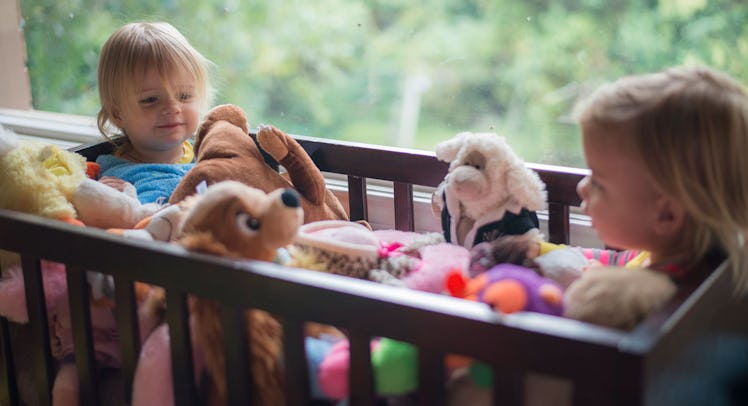How To Make Sure The Toys You Buy For Your Kid Are Safe
Don't play around.

When your kid is a toddler you’ll find they rarely have complaints about the toys you buy. After all, these are tiny people who are pretty happy banging on that old pot, climbing into a cardboard box, or turning a stick into pretty much anything. So, wait. Why are you buying them toys again?
baby playing in a box
Sure, they probably “need” more than a stick, a pot, and a cardboard box. But that’s mostly because none of those things have been branded by their favorite annoying animated franchise. So how do you make sure that the things you’re buying are only damaging your bank account and not their little brains and bodies? You’re in luck! There are some pretty simple guidelines for buying safe toys.
Safety Stats
You might be asking yourself, “Why you can’t I buy some okay-looking kid crap from the toy aisle of my local big box establishment? It’s a fair question, and one which can answered by a startling stat.
According to U.S. Consumer Product Safety Commission (CPSC) there were 254,200 toy related injuries reported in 2015. Of those, 35 percent of kids injured were under 5 years old. Strangely, none were related to weaponizing super-soakers. So, that must be pretty safe, then?
Buy Right
Making sure your kid doesn’t become just another number in the CPSC data requires a smidgen of thought. In other words, some light label reading, a touch of research, and some uncommon common sense.
The Label
When picking up a toy, the first thing you should do is check out the age recommendation. And understand that that age isn’t picked out of thin air, but is an expert opinion on how safe the toy is for certain age groups, along with how engaging and easy to use it is for that group. If only adults had the same guidelines, many would have never decided to play golf.
The label of any toy should also carry a couple of acronyms from regulatory bodies that deal with safety:
- All electronic toys should be “UL Approved” (which means that OSHA agrees they won’t electrocute your kid).
- Art toys should be labeled with ASTM D-4236 to signify the American Society For Testing And Materials has put them through their paces.
- All toys should carry a label of “nontoxic”
- Fabric toys should be washable and flame resistant
The Quality
One of the best ways to determine if a toy is going to be a piece of crapola that’ll make your kid cry is to give it a discerning once over. You’re looking — and feeling — for indications of a well-made toy. Poorly-made toys are liable to break and create dangerous edges. Pellets that present choking hazards often fill cheap stuffed animals. That’s a danger when Tigger The Tiger comes apart at the seams. Which he will, because that cat has … issues.
Less Obvious Dangers
Some toys can be tricky. They might appear to check out on all of the standards above, but turn out to be surprisingly inappropriate. Here are some less obvious things to keep in mind:
- Choking: Avoid marbles or detachable pieces that can fit in a kid’s windpipe. Need a simulated windpipe? Find a toilet paper roll. If a toy, or one of its constituent pieces, fits completely inside of that piece of cardboard it’s no bueno. This is also a brilliant excuse for when you forget to change the toilet paper roll. “Baby, it’s for our child’s safety!”
- Projectiles: Over 40 percent of toy injuries reported in 2015 occured around the noggin area. Don’t buy stuff that shoots. They’ll put their eye out, kid.
- Noise: Loud toys can jack up your kid’s hearing. Take out those batteries. Enjoy the quiet.
- Crib-ertainment: Keep anything that’s overly soft, or includes string or ribbon, out of a crib where they could inadvertently smother or wrap around a finger, foot, or neck.
The Loved Ones
Nobody wants to look a gift horse in the mouth. But that’s how you wind up giving a rabid horse to your kid. That’s a scenario that nobody wants to deal with.
So if your relatives aren’t paying attention to what they’re sending your kid, let them know these guidelines in the most gentle, low-key way possible. How could this possibly offend Granny? Think of the children!
These guidelines will give you peace of mind, which is at least something when your kid inevitably abandons the toys you bought them for a solid stick or study cardboard box.
This article was originally published on